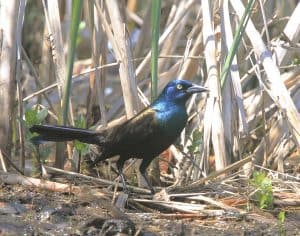
Where have all the grackles gone? Common Grackles are those large, glossy iridescent blackbirds. Males glow with a copper, blue and green sheen in the right light. They have light colored yellow eyes. Females are a bit less iridescent, more brown, with the light eye. Juveniles are all brown with a brown eye. Their song has been likened to the sound of a rusty gate opening. Common grackles are about a foot long from tip of bill to tip of tail. Their tail is long and wedge-shaped. When flying they can fold their tail in the middle, so that it looks as if the tail is twisted horizontally. This presumably reduces wind friction.
Just a few weeks ago and for most of the spring and early summer, our feeders were dominated by grackles, both adults and juveniles. They were eating ravenously and finished off all the seed and suet each day by noon. The smaller birds had all but given up even trying to get anything. But lately, we have, only one or two families of grackles coming to the feeder and there are long periods of time when the smaller songbirds and woodpeckers can get seed and suet. Other wildlife watchers have also reported that they have had far fewer grackles at their feeders lately. The feeders now provide nourishment to all birds most of the day and evening.
Common Grackles are true native North American birds. Reading the Mass Audubon website I learned that their breeding range is mid-Canada to southern Texas. After the juveniles have fledged, grackles band together for protection in large communal roosts, often in tall pine trees. On their wintering grounds, these roosts can comprise up to a million birds in one or two trees. In another month or so they will migrate south, but not far. Massachusetts is in their breeding territory but not many winter here. Most winter from southern New England (Connecticut and Rhode Island) to southern Texas. Looking through my Wildlife Watch spreadsheet for last year, I see that grackles were reported in Westford every month except December and January.
The most surprising fact I have recently learned about Common Grackles, is that they are in decline. According to Cornell Lab of Ornithology and National Audubon, they are on the list of “Top Twenty Common Birds in Decline”. Mass Audubon’s breeding bird survey found that grackles are indeed in a steep decline in Massachusetts. Their numbers have declined 58% since 1966. The reason for the decline seems to be habitat loss. Common grackles nest both in wetlands and in tall trees. But they like to inhabit edges along clearings, near areas of human habitation. They especially thrive in areas surrounding agricultural fields. As field environment transitions into forest, the habitat they need is eliminated. Grackles do not frequent heavily forested areas. So while we complain about the many grackles at our feeders in the spring and summer, perhaps we should show them more respect. Some day they might be an uncommon bird to see in Massachusetts.
Many thanks to all flora and fauna reporters for the month of August. Please send reports by September 26 for inclusion in next month’s column. You can write me at 7A Old Colony Drive, call me at 692-3907, or e-mail me at mariancharman@gmail.com.
Late July Reports:
Marian/Bill Harman, Old Colony Drive. July 26 and 27, female turkey sitting on our deck railing in the sun, preening, for hours. July 29, 80’s, humid, sunny. The number of grackles has declined a great deal. Now the seed and suet last a day or more. Baby red-bellied woodpecker with parents near the feeder. July 30, 85 degrees, humid. Large thump on the window. I checked outside and saw small gray feathers on the ground. I think a titmouse got chased by a hawk, was caught and taken away.
Alan Emmet, Concord Rd. July 28, I see monarch butterflies regularly, just one or two. They seem to appreciate the wildflowers on the hill behind the house: butterfly weed, Queen Anne’s lace, daisies, coneflowers, etc.
August Reports:
Marian/Bill Harman, Old Colony Drive. August 4, 75 degrees, beautiful. An adult female grackle hit the window and dropped onto the ground, was lying upside down, breathing heavily. As I touched her to pick her up, she righted herself, sat for a moment, dazed and looking around. Then she flew into a bush–Yay! At the feeder, male grackle feeding his begging youngster. A female showed up at the feeder this afternoon–hope it was the same one that hit the window earlier. Male red-winged blackbird at the feeder. Barred owl heard at night. August 6, 70’s-80’s sunny. A chipping sparrow at the feeder. August 7, 70’s 80’s, very humid, then a thunderstorm and downpour. Lots of adult and juvenile blue jays around (6 or 8), hummingbird at feeder. August 8, 70’s, humid, cloudy. A walk on the Pilgrim Village trails: saw a tiny, orange, translucent frog, baby toads, green frogs chirping and plopping into the brook. Heard Carolina wren, catbird, goldfinches. Odd not to hear the grackles and red-winged blackbirds in the brook now. Long northern water snake lying out on the pipe by the dam. Indian pipes up, blooming rattlesnake plantain. The bloom of the plantain is beautiful–first time I have seen it. Blueberries in fruit along the trail, blooming sweet pepper bush smells lovely. White water lilies and yellow bull lilies blooming in the pond and brook. One yellow coral fungus along the trail, lots of tan moths. The meadow has a whole large patch of blooming joe-pye-weed in the wet part of the field–gorgeous! Also goldenrod, white and purple asters. August 15, mama turkey watched vigilantly as her four or five poults dust bathed in the day lily garden. Three baby chipping sparrows following and bagging from parent on ground in same area. One large brown bat flew overhead at about 8 p.m.–first I’ve seen here. A few fireflies seen. August 25, cool and beautiful day. Two mother turkeys and their young have combined into a flock and today brought their dozen juvenile poults to the side daylily garden to dust bathe.
Marilyn Day, Graniteville Rd. August 5, owls excited and hooting back and forth last night.
Debbie Prato, Hayrick Rd., August 5. I have a lot of monarch butterflies. I always let a lot of milkweed grow among my perennials.
Diane Duane, Howard Rd. August 6, “Bill and I are raising monarchs. We have about 15 chrysalis and some little pillars that just hatched. My coworker has been doing this for the past year or so. She said less than 10% actually make it in the wild!” After about a month of raising them, we released our first monarch butterflies. All went well. [Diane sent great photos of the monarchs before release-MH]
Mary Lyman, at Main St. August 19, at the First Parish Church garden, a tiger swallowtail on the butterfly bush [Mary sent a lovely photo-MH] At Beaver Brook, a swan family with two parents and two juveniles. Also a great blue heron [Mary sent photos-MH}
Margaret Wheeler, Depot St. August 19, a milkweed tussock moth caterpillar on the butterfly bush [Margaret sent a photo-MH]. August 20, “Today Mark was walking in lightly wooded area beyond our garage when he encountered a lot of yellow jackets swarming around. He looked around and found that a six inch diameter stump had been knocked aside exposing a bee’s next in the ground. The area was undisturbed yesterday. Then about 50 feet outside the woods he found what looks like fresh scat. Given the size of the stump and the scat, he thinks it might have been a bear [Photos included. I agree! MH]
Barbara Theriault, Tadmuck Lane. August 24, “At 2 p.m. a coyote walked across the back yard. He then peered at me from behind the shed before walking into the woods. His face was exactly like the photo online of a coyote and his tail had some black markings.”
Marian Harman is a member of the Westford Conservation Trust, a non-profit organization whose purpose is the preservation of Westford’s open spaces and trails. The Trust welcomes new members and volunteers. Check out the Trust’s website at westfordconservationtrust.org or visit us on Facebook.
